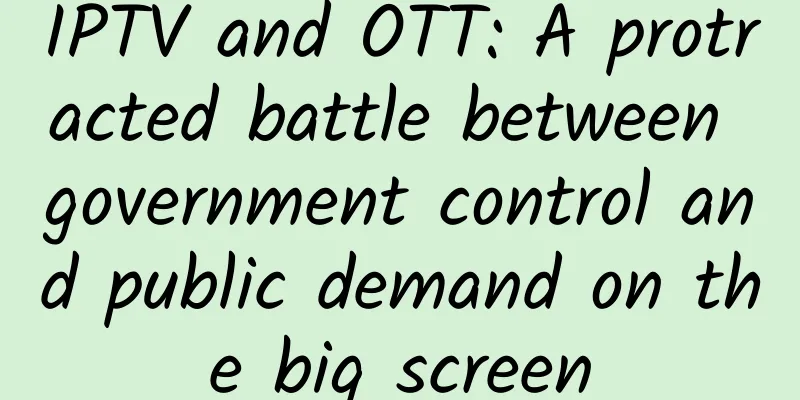IPTV and OTT: A protracted battle between government control and public demand on the big screen

|
Since 2012, IPTV has experienced the "wild growth of OTT". The popularity of OTT boxes in China has increased, and a battle to embed low-cost online videos into ordinary televisions has quickly begun. Many hardware manufacturers, Internet companies, and operators are vying to develop in this emerging field. The rise of OTT has had a great impact on the development of IPTV business, especially telecom operators, who have been hesitating whether to go the IPTV route or choose OTT. At that time, many people in the industry felt that IPTV technology was backward and the industry was closed, and believed that "IPTV is outdated and OTT is the new trend." This also led to the communication operators being in a state of hesitation from 2012 to 2015, so during this period, many places saw the mixed development of IPTV and OTT. However, with the decline of traditional telecommunications business, operators need to find new profit growth points, and IPTV just meets the transformation needs of telecommunications operators. In addition, with the determination of the three-network integration policy and the development of broadband, as well as the uncertainty of OTT policy in the past two years, IPTV has finally become the best choice for telecommunications operators. What are the characteristics and advantages of IPTV and OTT respectively? Let’s compare IPTV and OTT. From the perspective of transmission, IPTV services are stable. Although OTTTV is more flexible in technology, it is also easily interfered by other online activities, affecting the viewing effect. In terms of content, IPTV is limited by the content of the licensee, but has the relatively exclusive resource of TV station live broadcast and playback resources. OTT Internet TV on-demand content is relatively rich, but is limited by licenses and the supervision of the State Administration of Radio, Film and Television. In addition, from the perspective of the screen, IPTV and OTTTV are both large-screen TVs. From the perspective of business model, telecom's vast broadband user base, strong channels and execution capabilities, and clear revenue sharing business model are the best business practices in the current video industry. Currently, OTT is still developing rapidly, but from the perspective of business and matching of core resources, OTT has not done very well. However, with its innovative consciousness and thorough marketization, the advantages brought by OTT's development strategy are still worthy of attention. The business model of IPTV is relatively clear. As Shao Yiding, founder and CEO of Youpengpule, said, "People are very clear about what is a basic package, what is a value-added package, what is a single-point revenue sharing, and what is the placement and distribution of advertising resources based on the IPTV platform. Another feature of IPTV is that as the number of users and revenue grow, there can be a proportional relationship. And the core of IPTV is that there is no highest bandwidth cost in the service process." The biggest advantage of the IPTV business model is that it has completed a closed business loop from resource output to profit output. In addition, in the IPTV+ era, its business model is a deep integration of openness and closed loops, a full business linkage of "high broadband + strong TV + mobile phone linkage", and forms an ecosystem of "Internet open platform + smart terminal + operator". Therefore, whether in terms of productivity or operation, the IPTV business model can have a long-term evolution. In terms of policy, in the controllable Chinese environment, IPTV and OTT face completely different development trends. IPTV-related policies: From strict management to support, policies are the icing on the cake OTT-related policies: From 181 to 229, still manageable and controllable Through the above policy summary and combined with relevant information, we can find the characteristics and trends of IPTV and OTT at different development stages in recent years: In terms of IPTV, in 2010, the State Council issued the "Notice of the State Council on Issuing the Overall Plan for Promoting the Integration of Three Networks", which led to a dispute over IPTV broadcasting and control rights between radio and television and telecommunications. After radio and television finally obtained the IPTV broadcasting and control rights, IPTV business across the country gradually entered a period of steady development. Thanks to policy support, IPTV has shown a good development momentum and is gradually bearing fruit across the country. Although the development of IPTV was once impacted and squeezed by OTT, through a series of policies related to IPTV, we can also find that the State Administration of Radio, Film and Television and other departments have opened channels for IPTV by continuously issuing relevant policies. With the continuous advancement of the integration of three networks, IPTV has been developing gently and steadily. In 2016, IPTV ushered in its second spring. Compared with the moderate development of IPTV, OTT has experienced great ups and downs. Before 2011, Internet set-top boxes had not been recognized by the State Administration of Radio, Film and Television. In November 2011, the State Administration of Radio, Film and Television issued the famous "Document No. 181", and Internet TV set-top boxes were "regularized" by the State Administration of Radio, Film and Television. In 2012, the TV boxes on the market experienced an unprecedented explosion, among which copycat boxes occupied the majority of the market share. Until 2013, TV boxes were in the "wild growth of OTT" period. Faced with the chaos in the TV box market, the State Administration of Radio, Film and Television began to vigorously rectify the Internet set-top box market in 2014, continuously issuing new rectification regulations, which poured cold water on the Internet set-top box market. That is, starting from 2014, the Internet set-top box market began to enter a period of delayed development. Afterwards, Xiaomi, LeTV and other manufacturers have been exploring new development models. Both Internet companies and traditional TV manufacturers have relied on their own industrial systems to re-arrange their layout. In 2015, the State Administration of Radio, Film and Television further regulated the field of Internet TV, carried out content inventory and equipment rectification, and the vitality of OTT was restrained. To date, in terms of operational supervision, the State Administration of Radio, Film and Television has become increasingly strict in the OTT field. In terms of policy, IPTV's closed business system meets the needs of policy control, and its manageability and controllability are stronger than OTT. The government's attitude towards IPTV is already clear, and the policy risk is relatively small. In addition, due to the promotion of national policies such as "Broadband China", the three major operators are also working hard to promote the development of fiber-optic broadband, and IPTV is currently the only core basic value-added service bundled with the development of fiber-optic broadband. IPTV can also allow the people to truly feel some of the core changes brought about by the future 100M fiber-optic broadband access. In addition, IPTV advertising is more stable, and there is almost no policy risk in advertising and brand promotion plans. Yin Yuan, vice president of Shanghai Juli Media Technology Co., Ltd., once analyzed that DTV has the right timing, as it was born the earliest and is one of the channels with the best policy protection at present; IPTV has the right location, as it is the business that the three major operators have been promoting, and the three major operators can provide the best access to China's current network construction, but currently there are some deficiencies in user experience and content; OTTTV has the right people, as OTTTV is driven by Internet companies and the public, and the interactive experience and user perception of OTTTV are very good, but there is a lack of policy inclination and no rigid demand. In general, with the policy advantages and the background of operators, the development trend of IPTV is already clear, but while leveraging the advantages, it is also necessary to make up for the disadvantages and enrich the IPTV business. Although OTT has yet to explore the business model, relying on the technical background of Internet companies and the insight into user needs, and with the popularization of hardware devices such as smart TVs and smart boxes, the future development is still worth looking forward to. As a winner of Toutiao's Qingyun Plan and Baijiahao's Bai+ Plan, the 2019 Baidu Digital Author of the Year, the Baijiahao's Most Popular Author in the Technology Field, the 2019 Sogou Technology and Culture Author, and the 2021 Baijiahao Quarterly Influential Creator, he has won many awards, including the 2013 Sohu Best Industry Media Person, the 2015 China New Media Entrepreneurship Competition Beijing Third Place, the 2015 Guangmang Experience Award, the 2015 China New Media Entrepreneurship Competition Finals Third Place, and the 2018 Baidu Dynamic Annual Powerful Celebrity. |
<<: Baidu announces the opening of its autonomous driving platform
>>: China becomes the core driving force of global electric vehicles
Recommend
Sony PS 5 is in short supply, and the console King of Glory is expected to sell more than 300 million units in the end
A digital product that is not a financial product...
Practical methodology to improve SEM bidding promotion effect by 70%!
1. Introduction to SEM bidding Here, I need to sa...
The bullying incident among primary school students in Shanxi is shocking! How can we prevent it?
Shortly before the long holiday, an outrageous pi...
Coca-Cola Marketing Law
When you see this billboard , can you recognize w...
Ding Dong! The fruity natural fragrance you ordered has been delivered
Produced by: Science Popularization China Author:...
A suspected former employee of NIO broke the news in the early morning: the group is laying off employees on a large scale, and the delivery of 10,000 vehicles was "self-directed and self-acted"
At around 4 a.m. on March 21, a user nicknamed &q...
Used car auction platform Tiantianpaiche completes $100 million D1 round of financing, with Autohome as the investor
Tiantianpaiche, an online used car auction platfo...
Apple Pay is not mature: 80% of iPhone 6 users in the US do not use it
[[129069]] According to a survey of 1,000 iPhone ...
How much does it cost to join the Zhaotong luggage mini program? What is the price for joining the Zhaotong luggage mini program?
Is it easy to join the Zhaotong luggage mini prog...
Qin Zhiqiang: How to sell virtual products and public account SEO on WeChat, and easily earn 10,000 yuan a month by working part-time at home
Two years ago, knowledge payment became popular, ...
Latest research: Sunbathing can prevent dementia! But too much or too little sun exposure can cause dementia!
The team led by Professor Yu Jintai from Huashan ...
The ballpoint pen you use every day actually has so much knowledge
Many people don’t know that ordinary-looking stat...
Pink pink pink pink...pink attack, are you ready?
The recently released "Barbie" created ...
Lao Jiang's "Market Strategy" series: From the main players to the sellers - a deep decryption - the secrets of large institutional trading
Lao Jiang's "Market Strategy" serie...
Today, call 81192 again, please return!
"81192, please return!" Every year on t...









